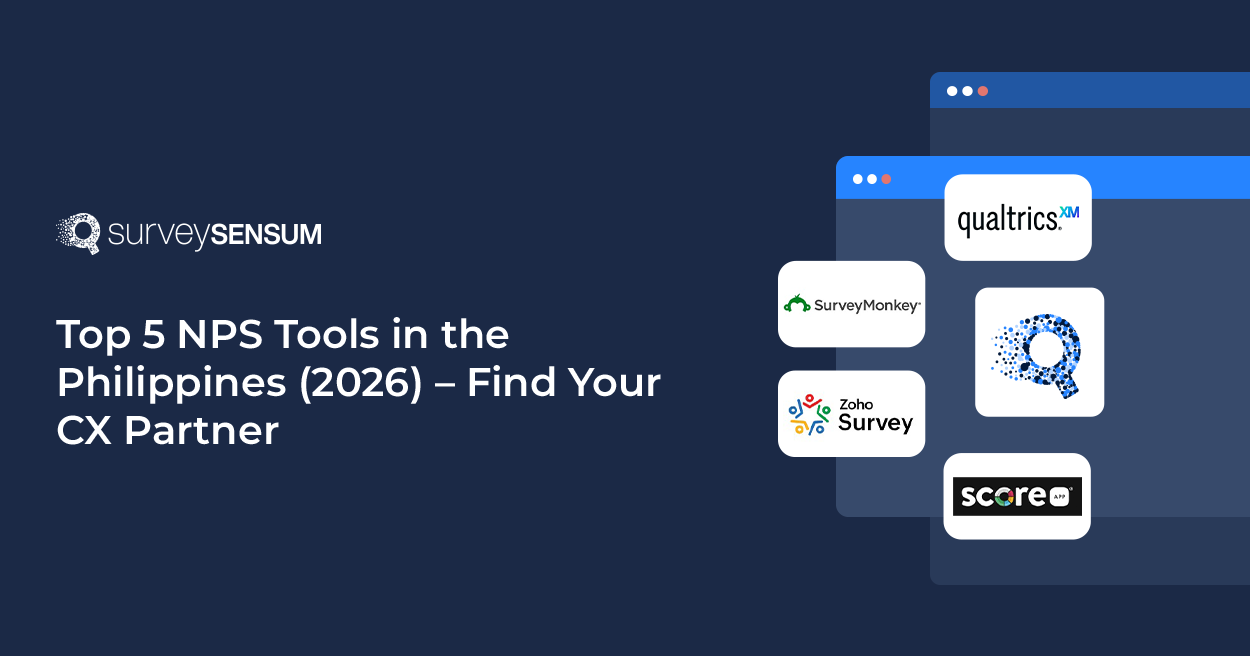


Want to know how exactly your customers feel?
Do you want to simplify their complex feedback?
Then, your one-stop solution is the Likert Scale!
In my journey of working with top companies across industries, to improve the customer experience, I have come to appreciate the significance and myriad benefits that Likert scales bring to the table.
These scales aren’t just rows of numbers – they’re a dynamic instrument that allows your customers to express their opinions and give feedback with precision and subtlety.
By offering respondents a range of options with Likert scales you gather customer feedback that is nuanced. The flexibility of Likert scales accommodates a wide array of responses, offering you a comprehensive overview of customers’ sentiments. Moreover, the clear and straightforward format of Likert scales simplifies the survey-taking process for your customers, enhancing the accuracy and reliability of the collected data.
Now, pair it with a robust customer feedback tool and you have in your hands the key to success for your CX program!
So, want to go on a journey to unravel the importance and discover the advantages of incorporating Likert scales into surveys, in detail? Scroll down!
But What is the Likert Scale?
First thing first – let’s start with the definition of a Likert Scale.
The Likert Scale is a rating scale that helps you gauge the attitudes or opinions of your customers. Named after the American social psychologist, Rensis Likert, this scale gives 5 or 7 different options ranging from one extreme to another for the respondents to choose from.
They are best used to understand how your customers feel about you, your service, or your product. Or when you want to dig more to understand customers’ reactions to a particular event such as after a webinar, on a new product features launch, after a customer onboarding, or post customer support.
Let’s understand this with an example.
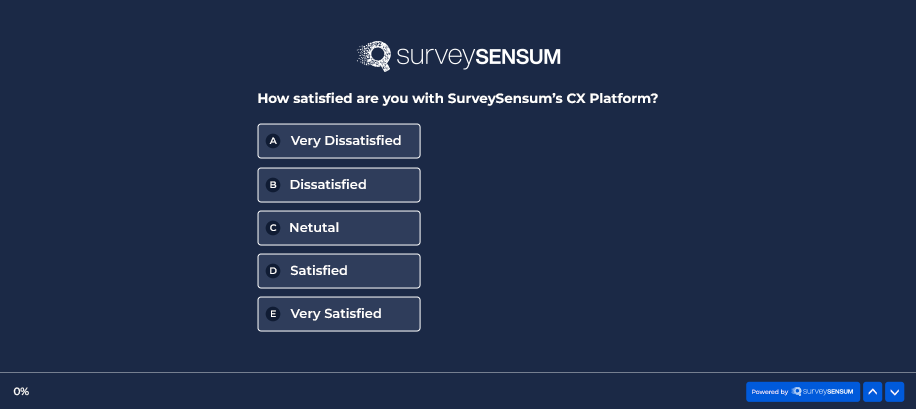
In the above question, I am asking my customers how satisfied they are with the SurveySensum CX Platform.
Their choice of answers ranges from very dissatisfied to very satisfied – giving me a straightforward answer on how they feel and making it easy for me to evaluate the overall results.
But is this the only scale I can use for the Likert scale survey or are there more?
Let’s talk about the different types of Likert Scale with examples, and their pros and cons.
What Are the Different Types of Likert Scales?
There are two main types of the Likert Scale.
- 5-point Likert scale
- 7-point Likert scale
1. 5-point Likert Scale
A 5-point Likert Scale offers five different options for the respondents to choose from. The options include two extremes, two intermediate, and one neutral opinion. This scale can be used for measuring agreement, likelihood, frequency, importance, quality, and a lot more.
Here’s a great example of a 5-point Likert Scale.
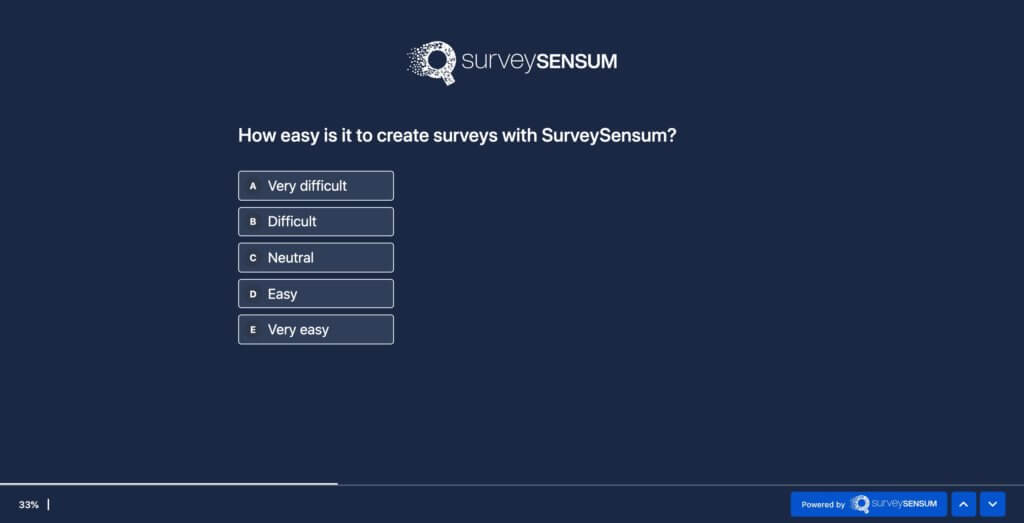
In the above question, I am asking my customers how easy is it to create surveys with SurveySensum.
I have provided them with 5 choices to choose from.
- Very difficult: It was very difficult for them to create surveys with SurveySensum.
- Difficult: It was a little difficult for them to create surveys with SurveySensum.
- Neutral: It was neither difficult nor easy for them to create surveys with SurveySensum.
- Easy: It was easy for them to create surveys with SurveySensum.
- Very Easy: It was very easy for them to create surveys with SurveySensum.
Their choice of answers ranges from very difficult to very easy – giving me a straightforward answer on how they feel and making it easy for me to evaluate the overall results.
But Why Should You Opt for a 5-point Likert Scale?
Now, let’s take a look at the pros and cons of using a 5-point Likert scale.
Pros:
- The 5-point Likert Scale is easily understood by the respondents.
- It is ideal to evaluate the results of a large sample of respondents.
- Giving five different options to choose from increases the response rate.
Cons:
- Customers have diverse mindsets with different feelings and responses. And this scale restricts them to five different options.
- If you want to understand the intensity of the customer’s positive or negative response or want to add more variants, then the 7-point scale is preferred.
So, simplify your feedback process with a simplified 5-point Likert Scale Survey!
2. 7-point Likert Scale
A 7-point Likert Scale is legendary and has been in use since 1932. It offers seven different options to choose from. It provides two moderate opinions along with two extremes, two intermediate, and one neutral opinion to the respondents.
Here is an example of a 7-point Likert Scale for frequency.
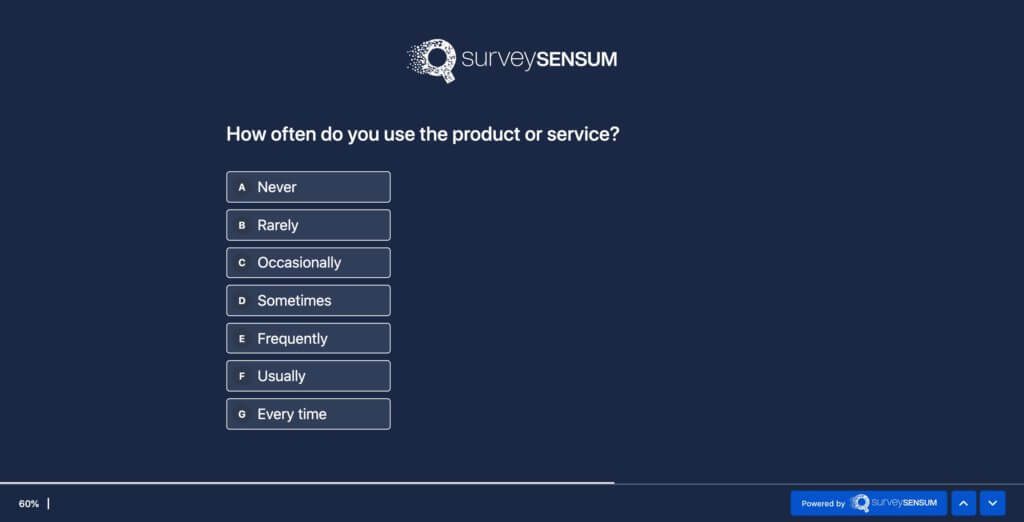
In the above question, I am asking my customers how often they use the product/service.
And I have provided them with 7 choices to choose from.
- Never: They never use the product or service.
- Rarely: They rarely use the product or service.
- Occasionally: They use the product or service occasionally.
- Sometimes: They use the product or service sometimes when it is required.
- Frequently: They use the product or service frequently but not regularly.
- Usually: They usually use the product or service in their day-to-day activities.
- Every time: They use they use the product or service every time they have the need for it.
Their choice of answers ranges from never to every time. This gives them multiple choices to express their frequency, giving me a straightforward answer on how they use the product.
Let’s talk about its pros and cons.
Pros:
- This is the most accurate of the Likert Scales as it captures the best sentiment of the respondent.
- It provides better accuracy in the results and is incredibly useful for researchers.
- It delivers more data points to run statistical information.
Cons:
- There is a negligible amount of quantitative difference in the data between the 5-scale and 7-scale variants.
- Seven-point Likert items suffer from bias in response style.
Elliot Simmonds, Research Director at DJS Research Ltd comments, “The decision between a five or seven-point Likert Scale is typically around granularity, e.g. are you expecting a range of answers and/or do you need to be able to identify differences between those who are, for instance, SATISFIED, VERY SATISFIED, and COMPLETELY SATISFIED rather than just (say) SATISFIED and VERY SATISFIED.”
However, Dan Kelly, Founder and Senior Partner at The Negotiator Guru suggests. “My suggestion is to use a 5-point scale when you have more than 100 respondents and a 7-point scale for smaller studies (N<100) when you need a better data distribution.”
Other Survey Scales To Use In a Likert Scale Survey
Alternatively, there are many other types of scales that you can use during a Likert Scale Survey
1. 2-point Survey Scale
Also known as a dichotomous or binary scale, this is the simplest of all scales. It offers two absolute opinions to the respondents such as yes and no, true and false, or agree and disagree. It delivers a clear indication of what you feel.
For example, here’s how I ask if our product is helping our customers achieve their goals.
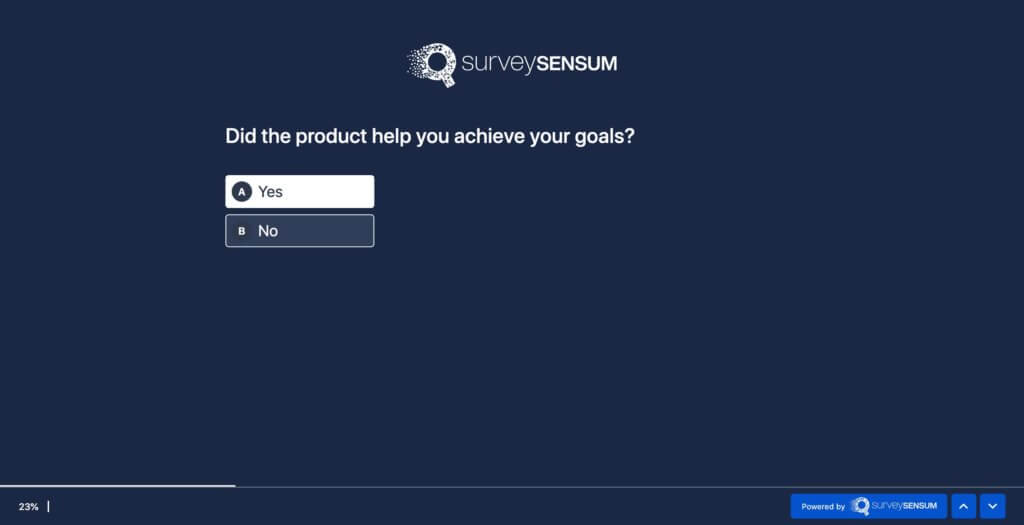
For example,
→ Are you satisfied with the product?
In the above question, I am asking my customers whether they are satisfied with the product or not and provided two options to choose from – Yes/No. However, the answers yes and no are enough to get a straightforward and quantitative answer to the question.
2. 3-point Survey Scale
The 3-point Survey Scale gives the respondents a middle ground. Along with two extreme opinions, it offers a neutral opinion to choose from.
For example,
→ How satisfied are you with our onboarding?
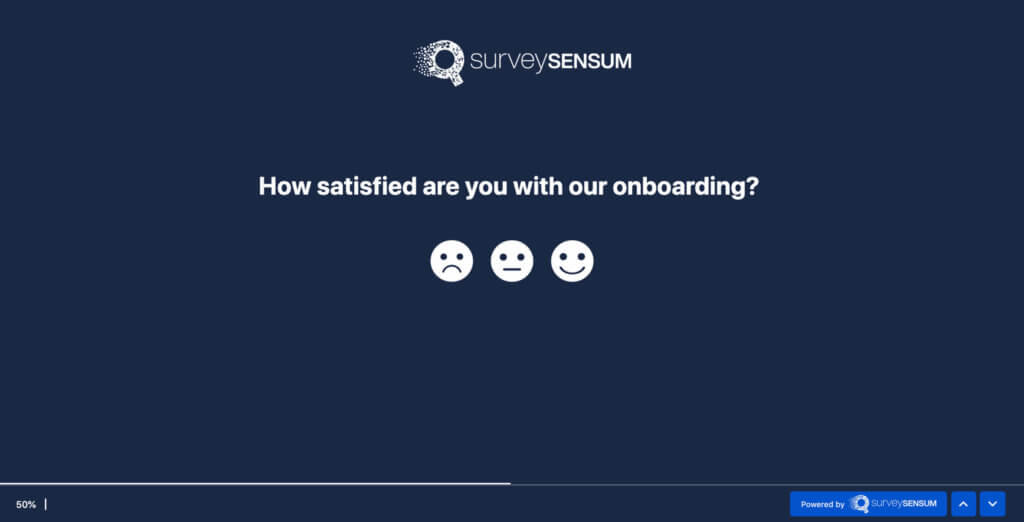
In the above question, I ask about my customer’s satisfaction with our onboarding process. I have provided them with 3 options, in the form of emojis, to choose from – unhappy to happy. However, this question still doesn’t offer much for the customers to choose from. So let’s head to the 10-point Survey Scale.
3. 10-point Survey Scale
The 10-point Survey Scale gives a much broader spread of the options to the customers and yields clear indicative results.
It can be used after onboarding, product launch, new feature launch or to evaluate the overall satisfaction of the customer with the brand.
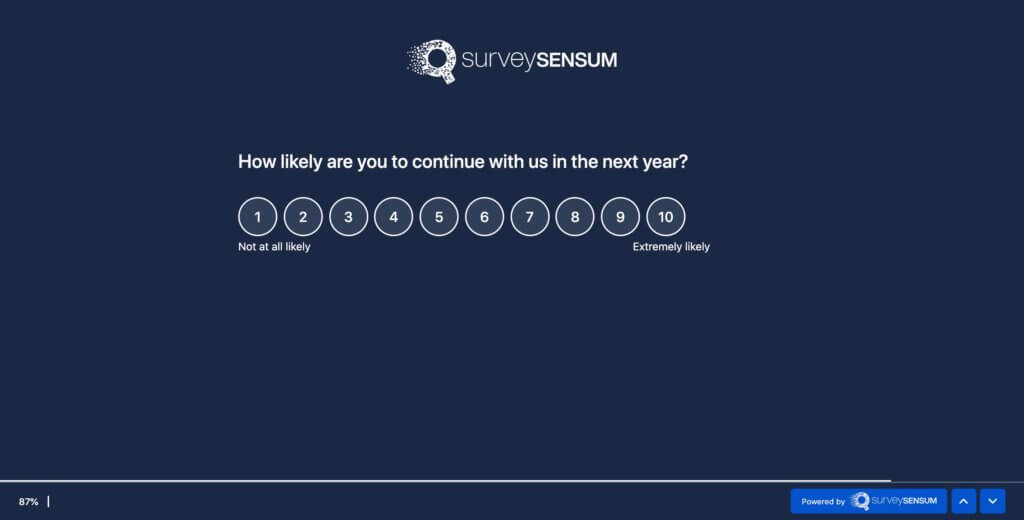
4. 11-point Survey Scale
The 11-point Survey Scale is an NPS scale ranging from 0 to 10. It gauges the loyalty of the customer towards the brand. In this, the customers who choose 9 and 10 are called promoters, the customers who choose 7 and 8 are called passives, and the customers who choose 0 to 6 are called detractors.

NPS is a business metric that can help you to measure customers’ overall perception of your brand. Relationship NPS helps you understand how your customer feels about your brand. Transactional NPS, on the other hand, can help you evaluate customer satisfaction after a certain interaction.
The reason behind increasing the scale points is to cover the diversity of customers’ mindsets as everybody has different responses and feelings. And if we just restrict them to a specific scale, it doesn’t cover most of the diversity.
Launch the NPS Survey and gauge customer loyalty with SurveySensum
Now you would ask, shouldn’t I just ask an open-ended question instead? Well, the results of the close-ended questions are easy to run statistical analysis on.
But the best approach would be to ask a close-ended question followed by a qualitative or say open-ended question.
Now that we have talked about the types of Likert Scale, let me share some tips that will come in handy while writing the Likert Scale questions.
How to Write Likert Scale Survey Questions?
- Be specific in the questions – If you are asking about the product’s performance, then which product are you talking about? To deliver the best results, framing your questions correctly with all the supporting details is critical.
- Label the options – Instead of labeling just the extremes, label all the options for the respondents’ clarity.
- Opt for a unipolar scale – The unipolar scale gives you options that range from none to maximum. For example, a unipolar satisfaction scale would give you options such as satisfied, slightly satisfied, moderately satisfied, very satisfied, and completely satisfied. The bipolar scale, on the other hand, gives you options that fall on two sides of neutral.
- Be careful with the sequence – While creating the customer satisfaction survey, make sure that for a horizontal Likert Scale, your answer ranges from negative to positive. 1/ negative attribute should be on the left and 5/7/ positive attribute should be on the right.
- Ensure consistency – If you have 4 questions in your survey, make sure that the options of all 4 questions are in the same sequence, be it from negative to positive or vice versa. This brings consistency to the survey and doesn’t confuse the respondents.
Now, that questions are written, let’s create an effective Likert scale survey with SurveySensum.
How to Create a Likert Scale Survey With SurveySensum?
Here’s how I create Likert scale surveys;
STEP 1: Sign up for the SurveySensum survey-builder tool.
STEP 2: Click on “Start survey” and select the survey template you want to create.
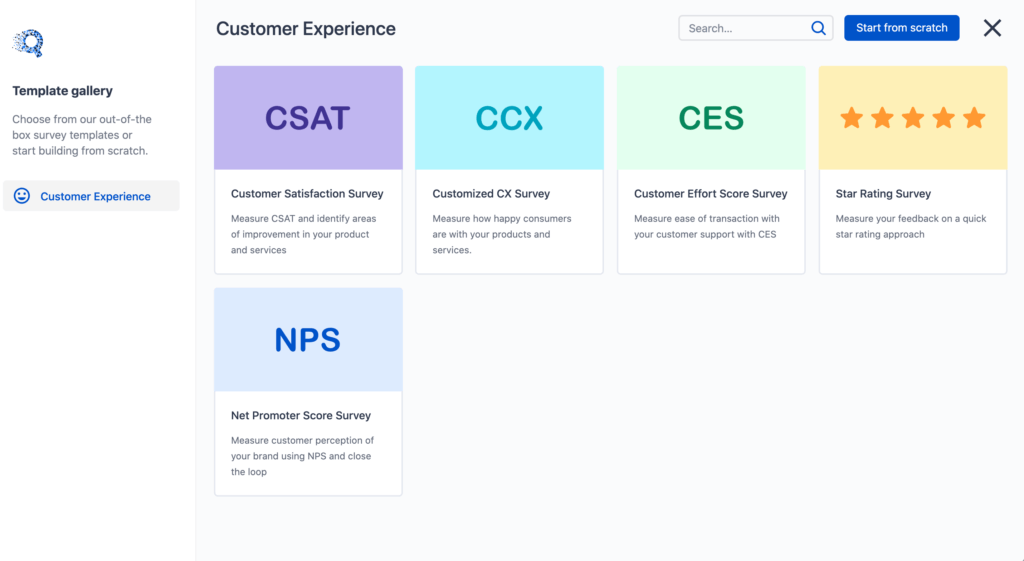
STEP 3: On the survey editor, select the “Likert scale” option in the types of questions. 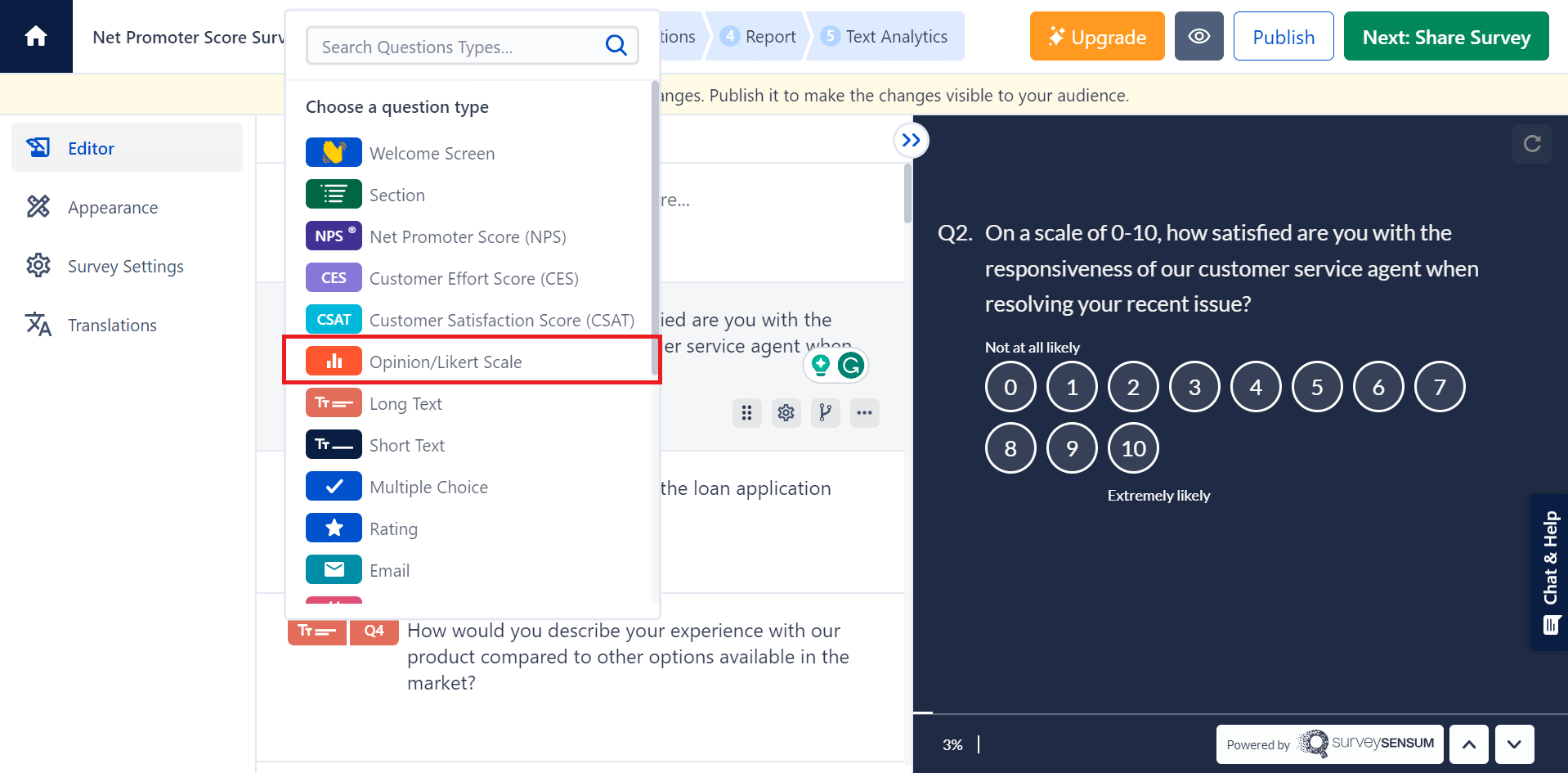
STEP 4: Now, you can personalize your survey by adding the questions, setting the scale, and changing the label name accordingly.
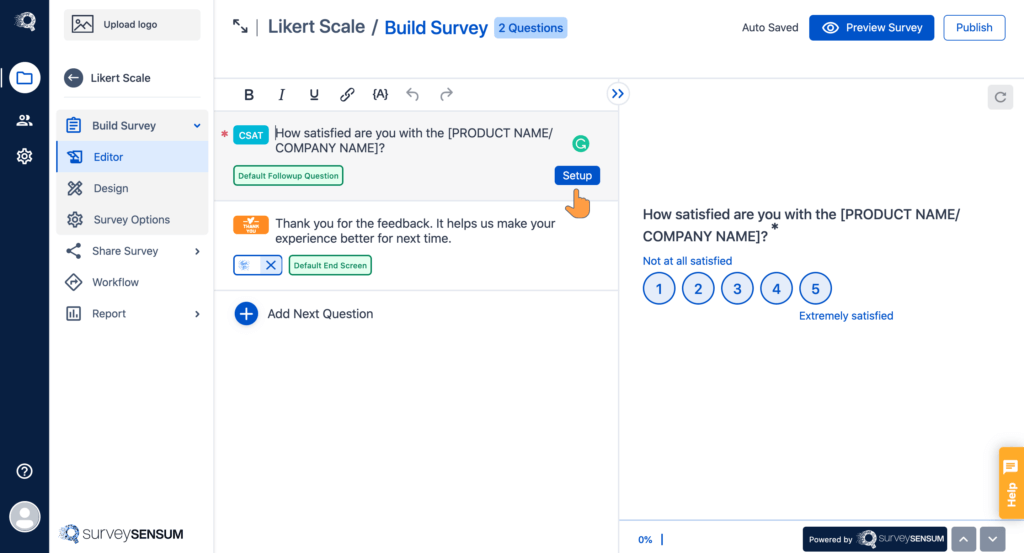
STEP 5: Once done, save and share the survey with your customers.
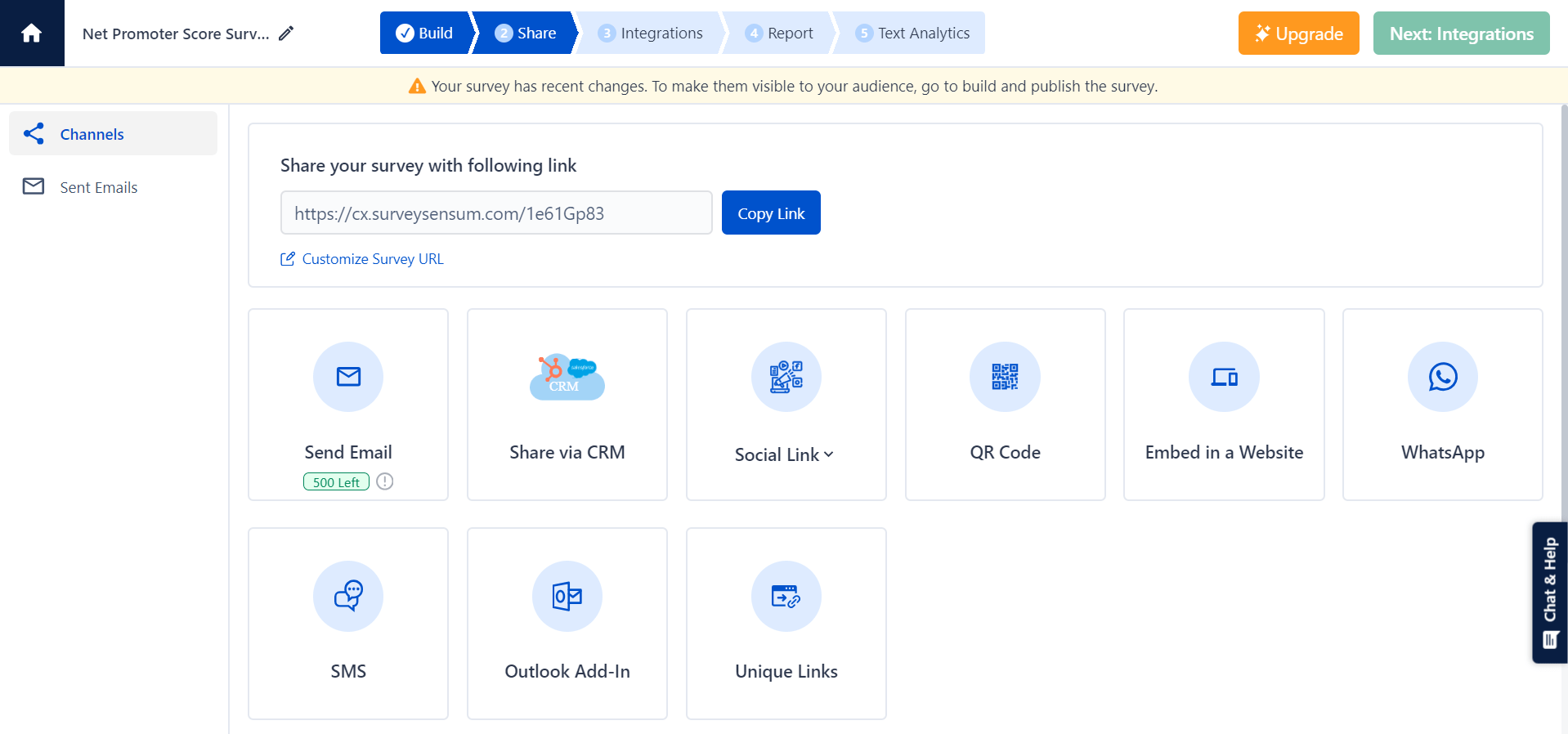
What are the Benefits of the Likert Scale?
There are many benefits of the Likert Scale
- Increased response rate: The respondents do not need to think much about the responses or spend time on them. Likert Scales offers plenty of different choices that reflect their sentiments to choose from. This increases the response rate.
- Analytical data: Likert Scales offers options to the respondents that have a simple yes and no option. The degree of opinion or even a neutral response is easy to quantify at the time of analysis.
- Neutral opinion: The neutral option allows the respondents to give a neutral opinion if they are not too sure about their feelings.
- Saves time: By giving the options to the customer, you are saving their time to take a survey and your time for analysis.
Start gauging customer feedback with Likert Scale
The Drawback of the Likert Scale
There are two major limitations to the Likert Scale.
- No Qualitative Data: If used without any open-ended questions, you will only gather quantitative data and not qualitative ones.
For example, you receive 2-star ratings from more than half of your customers regarding your customer support but why they are not satisfied is still unanswered.
- Response Bias: Using the Likert scale may result in response bias, as your customers are expected to choose between neutrals or extremes.
For example, a customer frustrated with your product might give a 1-star rating to your customer support agent because he was not able to resolve the issue.
Conclusion
To sum it up, the Likert scale is like your reliable sidekick in the world of gathering customer feedback – it’s versatile, widely used, and offers a structured approach. What makes it a star player are its simplicity, user-friendly nature, and knack for delivering solid data for statistical analysis.
But, let’s keep it real, every superhero has its kryptonite. For the Likert scale, one challenge is the room for response bias. Participants might lean towards neutral or socially desirable responses, resulting in the collection of unauthentic feedback. Also, the fixed response options? Well, they might miss the full spectrum of your customer’s perspective.
Now, in order to use this effective survey scale and create a balance between qualitative and quantitative data, you need a robust customer feedback tool, like SurveySensum, that will enable you to create effective surveys, analyze them, and extract actionable insights.
FAQs on the Likert Scale
A 5-point Likert scale is a psychometric response method where respondents can easily answer questions and state their level of agreement in five points. The 5-point Likert scale consists of the below points – (1) Strongly Disagree; (2) Disagree; (3) Neither Agree nor Disagree; (4) Agree; (5) Strongly Agree.
A Likert scale is a rating system that analyzes the attitude, perspective, or level of agreement of the respondents to a survey question or a statement. It can be used to gauge the quality, likelihood, importance, and understanding of certain items or services.
For example, a 5-point Likert scale will have the below corresponding values.
Strongly Disagree – 1
Disagree – 2
Neither Agree nor Disagree – 3
Agree – 4
Strongly Agree – 5
A 7-point Likert scale is a legendary gauging system and has been in practice since 1932. In addition to the 5-point Likert scale values, it gives you two intermediate options. A 7-point Likert scale seems to be the most accurate of all.
A 7-point Likert scale would be like;
(1) Strongly Disagree; (2) Disagree; (3) Somewhat Disagree; (4) Neither Agree Nor Disagree; (5) Somewhat Agree; (6) Agree; (7) Strongly Agree
A Likert scale is the best and most accurate measuring scale to understand the respondents’ attitudes and level of agreement with a survey question. It tells businesses the level of agreement or disagreement users have with your statements. Also, a Likert scale is like a social wall which is easy to launch and operationalize. It allows respondents to be neutral if they do not want to express strong disagreement or agreement.
You can calculate the Likert scale in the following way.
For example – (1) compute the total responses for each sentiment level, i.e., strongly agree, disagree, agree, etc.; (2) Multiply each numerical sentiment level value with the total responses received for that level; (3) Add the total values and derive a sum; (4) Divide the sum with the total number of respondents.
If you have multiple questions on the survey, you identify the score of each question and later add the numerical sum of all three questions. Then, divide the numerical sum by the total number of questions.
Now, you have the Likert scale score.












